F-69Chapter F:<strong>THE</strong> MAGNOCRAFT and its implicationsThe "Magnocraft" is the name given to a completely new kind of space vehicle,propelled by a pulsating magnetic field. The Magnocraft was invented entirely by the authorof this monograph. The main goal to be achieved through its invention is to obtain such adesign for an interstellar spacecraft that would make it possible for it to be produced by asmall country, or even by a large industrial corporation. How close we are to achieving thisgoal is demonstrated in the analysis of the attributes of the Magnocraft listed below:1. Its operation does not require any moving parts (theoretically speaking the wholeMagnocraft can be produced like a plastic balloon, i.e. from only one part). In comparison,the new Boeing 747 - 400 contains about 4 million individual parts.2. Its energy resources recharge themselves during flight (i.e. the energy lost duringacceleration of the vehicle is recovered during deceleration).3. Its completion can be achieved with our present level of knowledge.4. In theory all the problems that hold back its technical completion are alreadyresolved.5. It represents a vehicle of such an advanced level (technically and militarily) thatthe country which first builds it will gain leadership over the rest of our planet.As this was explained in subsection O1, the research on the Magnocraft was initiatedin 1972, when the author was conducting a series of lectures on "selected aspects ofpropulsion systems" for students of the Technical University of Wroclaw, Poland. Duringpreparation for these lectures he discovered that the inventions of subsequent propellingdevices are subjected to an astonishing regularity. Because this regularity depends on theperiodic repetition of the same characteristics in subsequent propelling devices, the authorcalled it the "Periodic Principle". The best illustration of this Principle takes the form of aTable shown as “Table B1” in monograph [1/4] and called the "Periodic Table". The firstsuch Table was published in the Polish journal Astronautyka no. 5/1976, pages 16-21.Periodic Tables are similar to the "Mendeleyev Table" (also called the "Periodic Table of theElements"), only that instead of chemical elements they illustrate propelling devices.Similarly as Mendeleyev Table did it to the elements, Periodic Tables also reveal propellingdevices still waiting for their inventors, and indicate principles which will be employed in thefuture operation of these devices. These new Tables are constructed by placing in thempropelling devices subsequently invented, in such a manner that these devices meet theconditions of horizontal and vertical symmetry. The horizontal symmetry (i.e. the belongingsof a given device to a particular row of the Table) defines a type of working medium andphenomena utilized in the operation of this device, whereas the vertical symmetry (i.e. thebelongings of this device to a specific column of the Table) describes the general class of apropulsion system to which this device is qualified. Fields of Periodic Tables, which have nodevices assigned to them, indicate propelling devices still awaiting invention. The position ofthese empty fields (i.e. their row and column) defines the future principles employed in theoperation of these devices yet to be invented.Through the analysis of his Periodic Table the author discovered that before 2036 acompletely new type of flying vehicle should be constructed on Earth. The propellingdevices (propulsors) of this vehicle will employ principles of magnetic attraction andrepulsion, and their operation will represent an advanced modification of contemporaryelectric motors. By utilizing the clues provided by the Periodic Table the author worked outthe design and operation of this new vehicle called here the Magnocraft. The first
F-70publication of this design and operation appeared in the Polish journal Przeglad TechnicznyInnowacje, no. 16/1980, pages 21-3.Detailed descriptions of the construction, operation, and properties of the Magnocraftare the subject of several separate monographs numbered [1/5e], [1/4e], [1e], and [2e] onthe list of references from the chapter S of this monograph. Monographs [1/5] and [1/4]elaborate all the matters mentioned here (e.g. it contains deductions of all equationsquantifying the Magnocraft, it presents the design and principles of operation of theOscillatory Chamber and twin-chamber capsule, it explains the marks scorched on theground by a landed Magnocraft, it presents the full version of the formal proof that "UFOsare already operational Magnocraft", etc.). Although the Magnocraft is a much moresophisticated vehicle than contemporary space shuttles and the complete description of itsdesign and operation would require at least the volume of an average book, for theunderstanding of the hypotheses outlined in this monograph even a brief knowledge of itsdesign and operation would be useful. Therefore in the descriptions that follow the mostimportant aspects of the Magnocraft, which have significance to the understanding of theorigin of the Tapanui Crater and the understanding of evidence documenting the magneticorigin of this Crater, are addressed.F1. The general design and components of the MagnocraftThe appearance of the Magnocraft is illustrated in Figure F2 (b). This vehicle takesthe general shape of an inverted saucer and it contains propelling devices placed in itscentre and around its peripherals. The propelling devices are called "propulsors" and theylook like transparent spheres which house cubes inside.The function of a Magnocraft's propulsor can be explained simply as that of anextremely powerful "magnet". We know that Earth, Planets, Sun and the Galaxy aresources of steady magnetic fields. These fields are able to lift a spaceship if it contains asuitably powerful "magnet" oriented so as to be repelled by them. Therefore theMagnocraft's propulsor is just such a "magnet" exerting repulsive or attractive interactionsonto the environmental magnetic field (i.e. the field of Earth, Sun, or Galaxy) to producepropelling forces capable of lifting a vehicle.The Magnocraft has two kinds of magnetic propulsors, i.e. main (M) and side (U) -see Figure F2 (a). The single main propulsor (M) is suspended in the centre of the vehicle.The magnetic poles of this propulsor are oriented so as to repel the environmental magneticfield (which could be the field of the Earth, a planet, the Sun or a galaxy). By this means,(M) produces a lifting force (R) which supports the craft. The magnetic axis of (M) is usuallykept tangential to the force lines of the environmental magnetic field existing in the craft'sarea of operation. Therefore the most effective orientation of the Magnocraft during flight iswhile its base is perpendicular to the local direction of the Earth's magnetic field.Sometimes, however, this orientation must be slightly altered to fulfil manoeuvring andlanding requirements.The Magnocraft consists also of numerous side propulsors (U). Their number "n"characterizes a particular type of this spacecraft and it depends on the design factormarked as "K". This number "n" is expressed by the equation: n=4 (K-1). All "n" sidepropulsors are located at regular intervals in the horizontal flange surrounding thespacecraft's base and covered with material penetrable to a magnetic field. Their magneticpoles are oriented so as to attract the environmental field. Therefore side propulsorsproduce attraction forces (A) which stabilize the craft and fix its orientation in space. Toincrease the vehicle's stability, the side propulsors are located below the main one, togetherforming a kind of bell configuration which in physics is known from its greatest stability.A basic component of each Magnocraft's propulsor is a cubical device called an"Oscillatory Chamber" (in the Magnocraft such cubes produce propelling forces, thus they
- Page 1 and 2:
Proof Copy ([5e/3] reformatted to P
- Page 3 and 4:
3G-83 G. Evidence certifying that M
- Page 5 and 6:
5Notes:(1) Before this monograph wa
- Page 7 and 8:
A-2or disk"). The information which
- Page 9 and 10:
A-4immune deficiency, thus it is qu
- Page 11 and 12:
A-6edition, 1986) even tries to arg
- Page 13 and 14:
A-8changes have no connection with
- Page 15 and 16:
A-10Fig. A2. The curved slope in th
- Page 17 and 18:
B-12inspired me to suspect that hum
- Page 19 and 20:
B-14Earth by evil UFOnauts God trie
- Page 21 and 22:
C-16#10. The spread, radiating from
- Page 23 and 24: C-18"Te Ura-a-Te Raki-Tamau", which
- Page 25 and 26: C-20item #2 that follows). Thus, in
- Page 27 and 28: C-22comparative data which reflects
- Page 29 and 30: C-24exploding fires, columns of fir
- Page 31 and 32: C-26banks of the Black Gully Creek,
- Page 33 and 34: C-28meditating, conducting healing
- Page 35 and 36: C-30deaths of people with symptoms
- Page 37 and 38: C-32(1) The Kawakawa volcano erupte
- Page 39 and 40: C-34The Tapanui Crater is the centr
- Page 41 and 42: C-36Fig. C2. The inner topography o
- Page 43 and 44: C-38(a)(d)(b)(c)(e)Fig. C4. Example
- Page 45 and 46: C-40Fig. C6. The illustration of si
- Page 47 and 48: C-42Fig. C8. The distribution of in
- Page 49 and 50: C-44Fig. C10. Two photographs of a
- Page 51 and 52: C-46Fig. C12. The location of near-
- Page 53 and 54: C-48Fig. C14. A magnetized metallic
- Page 55 and 56: D-50Chapter D:EVIDENCE THAT THE TAP
- Page 57 and 58: D-52including Mediterranean and Biz
- Page 59 and 60: D-54rapidly released by this explos
- Page 61 and 62: D-56experiments, and many more. Thi
- Page 63 and 64: D-58that people were in medieval ti
- Page 65 and 66: D-60then continually resonates in t
- Page 67 and 68: D-62"tapanui.htm") are to be met, s
- Page 69 and 70: D-64when such abnormalities of the
- Page 71 and 72: E-66Chapter E.HYPOTHESES EXPLAINING
- Page 73: E-68is directed towards the magneti
- Page 77 and 78: F-72can be built, each type taking
- Page 79 and 80: F-74sites an explosive growth of mu
- Page 81 and 82: F-76F4. Explosion sites of the Magn
- Page 83 and 84: F-78- Deficiency of some sensitive
- Page 85 and 86: F-80(a)…(b)…(c)Fig. F2. The des
- Page 87 and 88: F-82Fig. F4. The explanation for a
- Page 89 and 90: G-84The formal proof that "UFOs are
- Page 91 and 92: G-86civilization(s) sending UFOs mu
- Page 93 and 94: G-88the close proximity of the Tapa
- Page 95 and 96: G-90(c)(d)Fig. G1. Two photographs
- Page 97 and 98: G-92(a)(c)(b)(d)(e)Fig. G3. A spher
- Page 99 and 100: G-94(a)(b)(c)(d)Fig. G5. Pulsating
- Page 101 and 102: G-96(a)(b)(c)(d)(e)Fig. G7. Smooth,
- Page 103 and 104: G-98(a)(b)(c)(d)Fig. G9. Photograph
- Page 105 and 106: H-100#6. The Tapanui Crater is orie
- Page 107 and 108: I-102Chapter I:MORAL ACCENTUATION O
- Page 109 and 110: J-104explosion energy carrier would
- Page 111 and 112: J-106detonation a number of appropr
- Page 113 and 114: J-108resembled "china stones" from
- Page 115 and 116: K-110Chapter K:AROUND 13 500 YEARS-
- Page 117 and 118: K-112civilisation were prepared for
- Page 119 and 120: L-114Chapter L:STILL ANOTHER UFO EX
- Page 121 and 122: L-116Coincidentally, the author had
- Page 123 and 124: M-118in section D3). This in turn h
- Page 125 and 126:
N-120Chapter N:TWELVE TRUTHS ABOUT
- Page 127 and 128:
N-122only factors which may cause t
- Page 129 and 130:
N-124ones who stand by truth and th
- Page 131 and 132:
O-126Chapter O:ACADEMIC ASPECTS OF
- Page 133 and 134:
O-128Galactic field, thus producing
- Page 135 and 136:
O-130specifically what was wrong wi
- Page 137 and 138:
O-132moral field causes that we acc
- Page 139 and 140:
O-134white glowing balls of playful
- Page 141 and 142:
O-136brought disgrace to that unive
- Page 143 and 144:
O-138the Polish language only, whic
- Page 145 and 146:
O-140occupation of Earth, and then
- Page 147 and 148:
O-142in a few years of time, when t
- Page 149 and 150:
O-144and both these matters were se
- Page 151 and 152:
O-146today. We need to realize this
- Page 153 and 154:
O-148Of course, the above history i
- Page 155 and 156:
O-150two kinds of resource publicat
- Page 157 and 158:
R-152Chapter R:AT THE END OF THIS M
- Page 159 and 160:
R-154forget that such paid scientis
- Page 161 and 162:
S-156Chapter S:REFERENCES COMPLEMEN
- Page 163 and 164:
S-158[7/2] Giordano D. and Pajak J.
- Page 165 and 166:
T-160Magnocraft exploded over New Z
- Page 167 and 168:
Z-162Appendix Z:Directions for gett
- Page 169:
Z-164Fig. Z1. The most educational



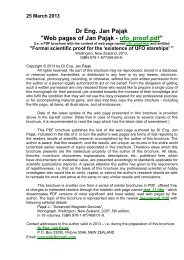


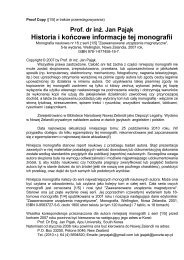
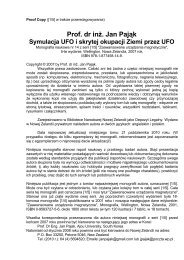

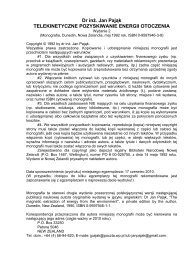
![[1/4p]: PDF - Totalizm](https://img.yumpu.com/45003232/1/184x260/1-4p-pdf-totalizm.jpg?quality=85)
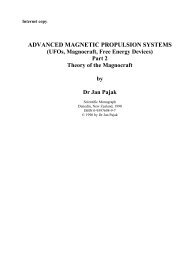
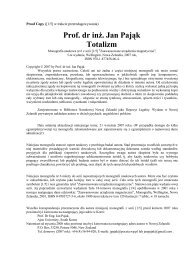
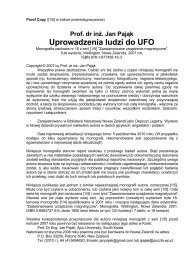
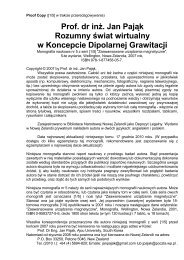
![[1/4p]: PDF - Totalizm](https://img.yumpu.com/39351336/1/184x260/1-4p-pdf-totalizm.jpg?quality=85)
